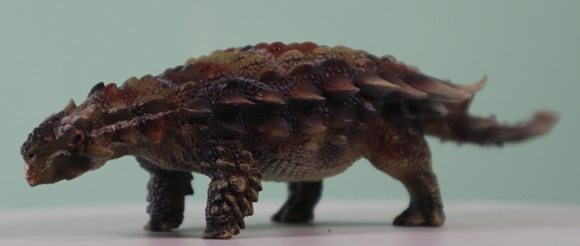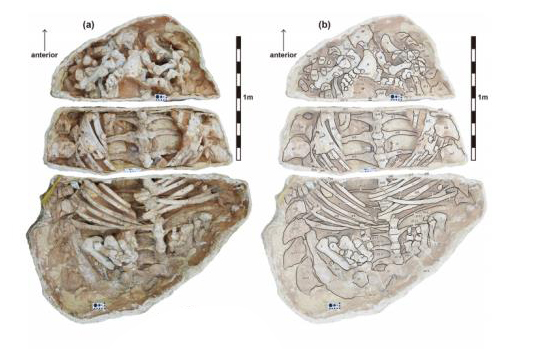A study of the fossilised remains of an as yet unnamed species of ankylosaurid suggests that these dinosaurs were adapted for digging. Whilst it seems unlikely that these large herbivores could have lived in burrows, they may have been able to dig for roots and tubers, excavate wells in dried up rivers to reach subsurface water and dig into sediments to obtain supplementary minerals in a similar way that extant elephants do today.

Picture credit: Everything Dinosaur
The model (above) is a Pinacosaurus armoured dinosaur from PNSO.
To view the range of PNSO dinosaur models: PNSO Prehistoric Animal Figures.
Digging Pits to Protect Their Undersides
Furthermore, many palaeontologists have postulated that these armoured herbivores might have been able to hunker down to defend their limbs and undersides from theropod predators. If these animals dug shallow pits they might have been able to protect themselves from attack and make it difficult for carnivorous dinosaurs to spot them when they were partially buried. Horned lizards (Phrynosoma) have a similar flat body and lateral fringe scales as seen in some types of ankylosaurid, these extant reptiles adopt these types of defensive strategies.
Discovered in the Early 1970s
Remains of an armoured dinosaur was first reported by a joint Soviet-Mongolian expedition to the southern Gobi Desert of Mongolia in the early 1970s. The skeleton consisting of dorsal vertebrae, elements from the limbs, ribs parts of the pelvis and the pectoral girdle along with several armoured scutes, was partially prepared for removal, but the excavation was not completed. The fossil specimen remained uncollected but crated up until 2008 when it was taken away for preparation by members of a Korean/Mongolian research team.

Probably a New Species of Armoured Dinosaur
The sandstone sediments of the Upper Cretaceous (Middle to Late Campanian stage), Baruungoyot Formation have yielded the remains of three ankylosaurid taxa, namely Saichania chulsanensis, Tarchia kielanae and Zaraapelta nomadis. Writing in the journal “Scientific Reports” the researchers which include such luminaries as Phil Currie and Eva Koppelhus (University of Alberta), Michael Ryan (Canadian Museum of Nature) and corresponding author Yuong-Nam Lee (Seoul National University, South Korea), state the unnamed ankylosaurid has some similarities to S. chulsanensis, but there are anatomical differences. Unfortunately, very little postcranial fossils of Tarchia kielanae and Zaraapelta nomadis have been found making it impossible to undertake a direct comparison with this specimen (MPC-D 100/1359).

Adapted for Digging
The scientists speculate that several anatomical features identified in MPC-D 100/1359 could indicate that this ankylosaurid was adapted for digging. The bones in its front feet are arranged in a shallow arc, which could have enabled it to dig soft earth. The fused vertebrae and the reduced number of bones in its hind feet, compared to other dinosaurs, may have helped anchor the ankylosaurid when digging or moving its tail. The body shape of MPC-D 100/1359, which is wider in the middle and narrower at the front and rear, may have helped its body to remain straight when digging. These traits such as the narrow-wide-narrow body shape and the manus (hand) and pes (foot) bone configuration are also known in other ankylosaurids.
Dig Those Ankylosaurs
Digging for resources out of reach from other animals and excavating shallow pits as part of a defensive strategy might have been prevalent amongst these armoured dinosaurs.

To read Everything Dinosaur’s article from 2014 about the discovery of Zaraapelta nomadis: New Species of ankylosaurid in Praise of Victoria Arbour.
The scientific paper: “A new ankylosaurid skeleton from the Upper Cretaceous Baruungoyot Formation of Mongolia: its implications for ankylosaurid postcranial evolution” by Jin-Young Park, Yuong-Nam Lee, Philip J. Currie, Michael J. Ryan, Phil Bell, Robin Sissons, Eva B. Koppelhus, Rinchen Barsbold, Sungjin Lee and Su-Hwan Kim published in Scientific Reports.






Leave A Comment